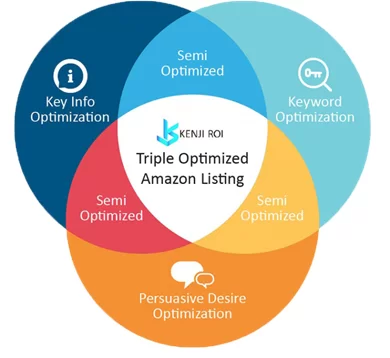
Triple Optimized Amazon Listings for Keyword & Conversion Domination
Editor’s Note: This is a guest post written by Danny Carlson, Founder at Kenji ROI.
According to a recent CNBC report, the coronavirus has “turbocharged a shift to eCommerce for many Americans.” In fact, this year, American consumers spent $211.5 billion online during Q2 of2020.
As a result, there’s good reason to believe that eCommerce is on an all-time high and that this is no trend; this is reality, and it’s our new normal. Any seller worth their salt will want to do their very best to grab a piece of that economic pie – easier said than done.
Selling on Amazon can be challenging and cash-intensive, to say the least. Here we’ll cover how to tripartite optimization that gets your product in front of your market, and convinces them that your product wins over the competition
A triple-optimized listing:
- Employs the correct keywords to rank yourself as high as possible. No further than page 2 or you hurt your conversion.
- Employs the right sales language — walk the fine line between hard-sell and way-too-subtle in your sales speech.
- Employs language that speaks directly to your consumer to convince them that, beyond the shadow of a doubt, (a) your product is the absolute best, and (b) they simply can’t live without it. Yes, even if you’re selling a fidget spinner.
Kenji ROI is an Amazon Listing Optimization agency with 5 years experience serving mid to large sized brands selling on Amazon.
KenjiROI’s three-prong process utilizes the following to maximize performance:
- Keyword Optimization
- Key Info Communication
- Persuasive Desire Optimization
In Danny’s words, when you add 1 + 1 + 1, you get 5 — or an exponential effect on your conversions.


Part 1: Keyword Optimization
There are three different types of keywords that go into a listing. In no particular order of importance, they are:
- Amazon PPC
- Front End
- Back End
PPC involves your paid Amazon advertising, whereas your front and back end keywords cover your organic SEO. Find an equilibrium among all three in order to rank your product.
Common mistakes in Amazon SEO:
- Prioritizing PPC and ignoring organic
- Strike a balance between both types to increase your chances of getting seen by your target market.
- Keyword stuffing.
- Big no-no. Humans buy, not algorithms. Employ human readable Amazon SEO to increase your performance. Keyword stuffing isn’t appealing to humans. Your sales will go down, Amazon will notice, and your rank will decrease.
Bottom Line? Employ the best practices in Amazon SEO to increase rank. Get yourself seen, so that buyers know you exist.


It’s a common mistake. Product developers and sellers are so close to their product, they fall deeply in love with it, and forget that the one doing the actual buying is not them! The crucial part of any successful listing is employing the language and product characteristics that people look for.
Your images need key info optimization, too. Is the lighting good? Have you employed lifestyle shots to illustrate how customers can fit the product in their lives? Do graphic elements increase the value and communicate the product’s worth?
Keep in mind that Amazon wants people to click off your listing. On your listing page — which is technically your real estate, your digital boutique, your online kiosk — Amazon will feature competing products. That’s okay. Because if your image is hyper-optimized and your product title balances keywords and human optimization, you’re already winning.
Part 2: Persuasive Desire Optimization
Danny defines persuasive desire optimization as “using sales psychology to portray your product as the bridge from your customer’s undesirable current situation to an improved future situation.”
In a nutshell, this employs persuasion and psychology to turn a want into a need.
How is this done, exactly?
There’s a copywriting formula called PAS. It’s used world-over as a simple and effective way to penetrate the pain points of your target avatar. It starts by identifying a pain point (p). Then it continues to agitate (a) the pain point. It wraps up by positioning the product as the solution (s) to the problem. Through this straightforward method, customers understand that a product spells the difference between their current pain and a happy future that’s devoid of this pain.
The best part? This formula holds fast for any product under the face of the sun. You could apply persuasive desire optimization to any category, from kitchenware to baby products to essentials like soap and hand sanitizer — and even to luxury goods.
A 5-Star Listing
In conclusion, use three steps to optimize your listing:
- Keyword optimization
- Key info communication
- Persuasive desire optimization
Combined, these three steps lead to a 5-star listing — one that understands the customer’s needs and pain points, and how to solve them; one that understands how to maneuver around the complex Amazon algorithm; and one that provides the accurate information needed to lead to conversion.
In this case, 1 + 1 + 1 doesn’t equal 3 — it leads to a stellar listing!






